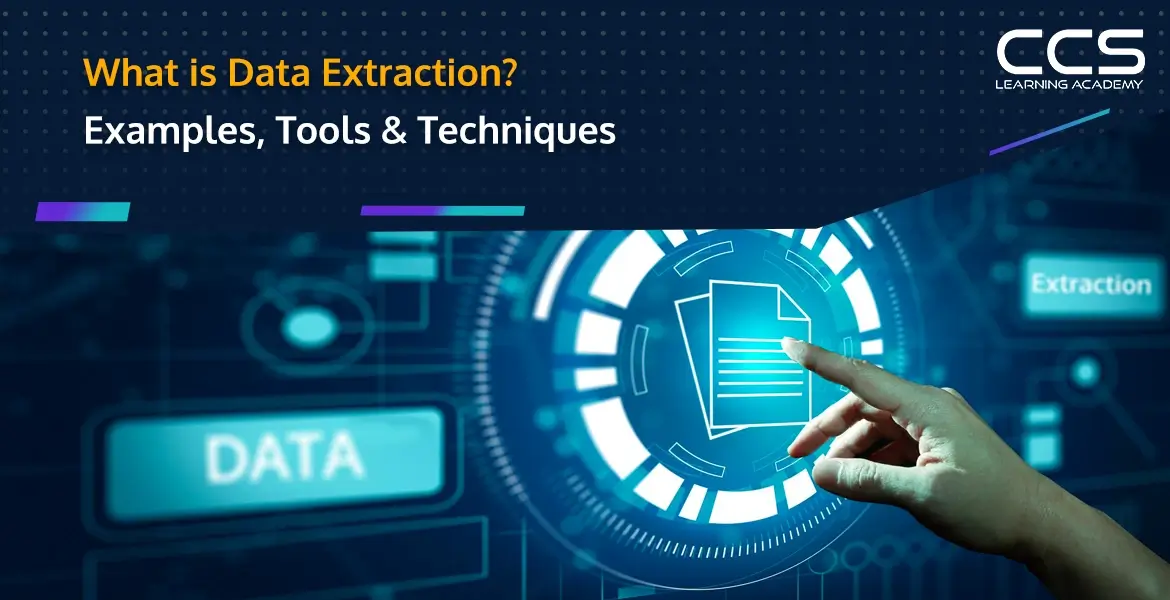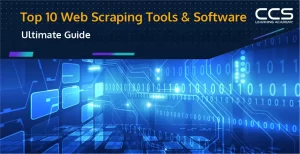What is Data Extraction? Examples, Tools & Techniques
- -
- Time -

Modern analytics is built on data extraction, which helps businesses mine enormous amounts of data for insightful information. Fundamentally, data extraction is the process of obtaining unprocessed data from many sources and transforming it into an organized structure that can be examined.
This process is facilitated by several tools and strategies, like database querying and web scraping, which help businesses make educated decisions and promote growth. Now, let’s explore the nuances of data extraction, looking at valuable tools, examples, and strategies along the way.
Table of Contents
- Why Do You Need Data Extraction Tools?
- What is Data Extraction?
- Types of Data Extraction
- Data Extraction Process
- Examples/Use Cases of Data Extraction
- What is the Importance of Data Extraction?
- Data Extraction Techniques
- Data Extraction and ETL
- Can Data Extraction Happen Without ETL?
- Data Extraction Methods
- Top Data Extraction Tools
- Data Extraction vs. Data Mining – Comparison Table
- Ending Thoughts
- FAQs
Why Do You Need Data Extraction Tools?
Businesses today collect a lot of data, but it is kept in their systems, offering them no good. It is often in their POS system, Facebook account, website, PDFs, or any other document form. The most important question is how to feed this data into your analytical system. As necessary as it is to gather data, it is more important to extract it so that it can be used for a reason.
Surprisingly, 68% of data businesses collect is never used. That is why data extraction is critical for companies today. For this, you must ensure that your first step is getting started with data extraction.
What is Data Extraction?
It is the process of pulling proper, targeted information from a vast chunk of data. Massive logs of unstructured data sources, including emails, recordings, and postings on social media, are the first thing it works with. Then, by using a data extraction tool, you pull out the information you need, such as user demographics, usage habits, contact information, and financial numbers.
Once this is separated, it can be used to create actionable resources, such as ROIs, targeted leads, operating costs, margin calculations, and more.
Types of Data Extraction
In a broad sense, two types of data are extracted:
#1. Unstructured
This kind of data is not saved in any database in a structured or standardized format. There is a lot of unstructured data produced by machines and humans. Some examples are email, audio, sensor, geospatial, and surveillance data. All this data comes commonly from IoT or the Internet of Things.
Businesses must first begin with data preemption and cleansing operations where duplicate results and extra symbols must be deleted. They must also establish how the missing data values should be handled before extracting from the unstructured data.
#2. Structured
Standardized methods are used in transactional systems to store and handle structured data. Structured data is represented by rows in a SQL database table. When dealing with structured data, businesses often extract the information from a source system.
Data Extraction Process
Data extraction happens in five phases, which are as follows:
- Ingesting – It is the first step in which all the data is ingested. This means that the relevant documents and systems must be prepared and identified.
- Converting – After the data is ingested, it must be assessed. The data must be transformed into a legible and searchable format if it needs to be explained. To do this, optical character recognition (OCR) is frequently used.
- Classifying – After converting, the data is classified. In this phase, each data piece is classified into an accurate and logical category. These categories are set up through different indicators.
- Identifying – In this phase, regular expression technologies are used. Once done, the dataset becomes searchable.
- Extracting – This is the final step once the data is identified for extraction according to a rule-based framework. This means that the necessary action may be taken on the data when it is identified, provided that rules have been established for it. Here, extraction is the activity.
Examples/Use Cases of Data Extraction
Data is widely used across industries and irrespective of the nature of business, data extraction will always come in handy.
- Let us take an example of a mortgage company. They may use this data extraction for gathering contact information out of a repository of pre-approved applications. This allows the mortgage company to design a database of qualified people who may take advantage of their services or offers in the future.
- Another example is data extraction can also help in automating the invoice process so that VAT compliance checks, payments, accounting, and record-keeping can also be automated. Through this automation, companies can invest in further analysis and use these insights for critical decision-making processes.
- Data extraction can also be helpful for financial institutions as they rely heavily on data. They need data to analyze market trends and make business decisions. With the help of data extraction tools, they can extract massive financial data from multiple sources, such as websites, stock markets, and news articles. They can further use this extracted data to analyze patterns, trends, and market movements and prepare investment strategies.
What is the Importance of Data Extraction?
Data extraction is one of the most vital elements that drive the analytical workflow of any organization. With the help of data extraction, businesses can gain insights needed to make business decisions and uncover patterns to enhance productivity while driving innovation.
Data extraction is the cornerstone of organizing and cleaning data and further preparing it for storage in a particular system or use for data analytical purposes. Additionally, data extraction is necessary for the ETL process, cloud-based systems, and raw data copying, analysis, and preservation.
You can use various automated data extraction tools instead of manually extracting your data. These tools save you time and cost and improve accuracy. Additionally, they also assist businesses in streamlining their data management practices.
Here are five ways in which data extraction can be beneficial for the companies:
- It can help save costs.
- It can assist in making faster business decisions.
- It reduces the risk of manual errors.
- It also reduces the time to market period.
- It increases scalability.
Data Extraction Techniques
Data extraction techniques are necessary for the data migration process. It is also needed to manage the collection or retrieval of data from different sources. Many factors contribute to an effective data extraction technique or process, such as data sources, accuracy of extracted data, and extraction methods.
To perform successful data extraction, you must be aware of the technical know-how to manipulate tools and navigate databases, as well as know how to discern and select the correct data while ensuring its applicability and integrity. To become an expert in this, you can enroll in a data science bootcamp by CCSLA, where you can gain an understanding of every process in detail.
There are four kinds of data extraction techniques and the selection is done based on the data source. Those four techniques are:
- Association
- Classification
- Clustering
- Regression
Data Extraction and ETL
There are two ingestion processes – ETL (extract, transform, and load) and ELT (extract, load, and transform) and data extraction is their first step. As part of an all-encompassing data integration plan, the goal of these operations is to prepare data for analysis or business intelligence (BI).
Let’s understand the ETL process for comprehending data extraction better:
- Extraction – It is about gathering data from multiple sources. It includes finding and identifying relevant data and preparing it to be transformed and loaded.
- Transformation – It is where the data is stored and organized. The data is also cleansed, and missing values are removed. Depending on the destination, this transformation can include JSON structuring, data typing, time zones, and object names to ensure compatibility with data destinations.
- Loading – It is the last step in which the transformed data is delivered for future analysis.
Can Data Extraction Happen Without ETL?
Data extraction can always happen outside of ETL. However, there will be limitations attached to data extraction without a proper data integration process. If raw data is extracted but not correctly loaded or processed, it might be hard to organize and analyze, and it might not work with more recent software.
Hence, this kind of data may only be helpful for archival purposes and significantly less for anything else. It would be more beneficial for you to extract your data using a comprehensive data integration solution if you intend to transfer data from outdated databases into a more modern or cloud-native system.
Another possible drawback of doing it without ETL is compromising efficiency, especially if the extraction happens manually. It can be tricky and challenging to go for a hand-coding process as it can lead to errors and may also be difficult to replicate across different extractions. Simply put, you may have to rebuild the entire code from scratch if you perform extraction at a different place.
Data Extraction Methods
Many data extraction methods are present, and they vary based on business needs, velocity, volume, and data use cases. Some of them are:
- Full Replication/Extraction – This is a standard method for populating a target system for the first time. It entails transferring all of the data from the source system to the destination system by extracting and reproducing it. Complete extraction often maintains all of the relationships between the data and is logical. Another way to conserve computer memory would be to extract data while excluding particular data using an offset setting.
- Structured Data Extraction – Data prepared in accordance with defined models, which prepares it for analysis, is referred to as structured data. Logical data extraction is a reasonably simple technique that may be used to extract it. There are two varieties of structured data extraction: complete extraction and incremental extraction.
- Incremental Load – In this method, only the changed or new data is loaded into the target. It is much quicker and lightweight than the full extraction method. This is because a smaller volume of data is used in this process. However, the concept behind loading data is complex. Hence, in some cases, it can be tricky to parse. Luckily, different transformation and ingestion tools can help in making this job easy.
Top Data Extraction Tools
Listed below are the top data extraction tools that can be helpful:
- Invantive Control for Excel
- MonocomSoft Web Phone and Email Extractor
- Astera ReportMiner
- Open Telemetry
- PhantomBuster
- Microsoft Graph Data Connect
- AmazingHiring
- Hyland Document Filters
- Captain Data
- Mailparser
Data Extraction vs. Data Mining – Comparison Table
| Parameters | Data Extraction | Data Mining |
| Definition | It is the process in which specific and usable data is retrieved from unstructured or semi-structured sources. | It is about discovering trends, insights, and patterns from a large dataset. |
| Use cases | Needed for creating usable and preprocessing datasets. | Needed for prediction, knowledge discovery, and decision support. |
| Goal | To remove and process data so that it may be organized and analyzed systematically. | To find essential patterns and hidden information in data so that decisions may be made. |
| Examples | Taking out customer information from emails. | Finding customer segments according to purchase behavior in sales campaigns. |
| Data source | Generally poorly structured or unprocessed data. | Use datasets or structured data that have already undergone extraction. |
| Output | Structured dataset ready for analysis. | Trends, relationships, patterns, and knowledge discovery. |
| Primary focus | Structuring and preparing data. | Analyzing and generating valuable insights. |
| Key techniques | Transformation, data cleansing, and organization. | Classification, data clustering, regression, anomaly detection, and association rule mining. |
Ending Thoughts
To sum up, data extraction is an essential first step towards revealing the wealth of information concealed within enormous data stores. To get a competitive advantage, businesses may effectively collect, convert, and analyze data by utilizing a range of tools and procedures that are customized to meet their requirements.
In today’s data-driven world, where technology is constantly changing and data quantities are rising, innovation and strategic goals can only be achieved via a mastery of data extraction. If you want to excel in this field and become a master of data extraction, you can enroll in the data science boot camp by CCSLA. This course will equip you with all the tools needed to advance your career in this field. Moreover, in just 12 weeks, you can complete the course and start your journey in the world of data.
FAQs
Data extraction is the process of retrieving unstructured or structured data from various sources, such as databases, websites, and documents. The purpose is to repurpose the data for analytical processing, integration with other data, or storage in a centralized repository.
Data extraction is crucial for data integration and big data initiatives. It enables organizations to aggregate and transform data from multiple sources, providing a comprehensive view of business operations and customer interactions, which is vital for making informed decisions.
Common techniques include web scraping, where data is pulled from web pages; database extraction, where SQL queries retrieve data from database systems; and API extraction, where data is obtained through APIs that provide direct access to external systems’ data.
Examples include extracting customer information from CRM systems for marketing analysis, pulling transaction data from databases for financial reporting, or using web scraping to gather competitor pricing from e-commerce websites.
Tools vary depending on the data source and requirements but can include web scraping tools like Octoparse and ParseHub, ETL (Extract, Transform, Load) tools like Talend and Informatica, and more specialized software like data capture tools for extracting data from PDFs or images.
Challenges can include dealing with large volumes of data, ensuring the accuracy and reliability of extracted data, navigating complex data structures, and addressing legal and privacy concerns related to data usage.
While often used interchangeably, data scraping specifically refers to extracting data from websites, typically using bots or web crawlers. Data extraction is a broader term that encompasses retrieving data from various formats and sources, not limited to the web.
Best practices include clearly defining the data requirements, using reliable and efficient extraction tools, ensuring regular updates and maintenance of the extraction processes, and adhering to legal and ethical standards, especially in terms of data privacy.
By facilitating the consolidation of data from diverse sources, data extraction allows businesses to gain a holistic understanding of operations and market conditions, enabling better strategic planning and targeted business intelligence initiatives.
Future trends include the increased use of artificial intelligence and machine learning to automate and refine data extraction processes, greater emphasis on real-time data extraction for timely insights, and enhanced integration capabilities with cloud-based data analytics platforms.






